
Researchers at the University of Gothenburg, working with French colleagues, have successfully developed a method able to kill the aggressive brain tumor glioblastoma. By blocking certain functions in the cell with a docked molecule, the researchers cause the cancer to die of stress.
Cancer cells, especially those that form aggressive tumors, are in one way or another out of control and live a very stressful existence. To manage this stress, the cancer cells hijack mechanisms that the healthy cells use to regulate protein production and process the surplus proteins that they create. Without these hijacked mechanisms, the cancer cell would die.
“We have now succeeded in stopping this hijacking by inserting a specially developed molecule in the cells that inhibits one of these hijacked adaptive mechanisms in the cancer cells. This causes the cancer to self-destruct,” says Leif Eriksson, professor of physical chemistry at the University of Gothenburg.
Swedish-French collaboration
Leif Eriksson’s group has worked with a research group at INSERM in Rennes, France. Using super computers and advanced simulations, the researchers developed a version of the molecule that can also pass through the blood-brain barrier that protects brain tissue. They have presented their findings in the journal iScience.
The breakthrough applies to glioblastoma brain tumors. These make up about 45 percent of all brain tumors and around 400 Swedes are diagnosed with glioblastomas every year. For the EU as a whole, there are 19,000 cases annually. Currently, the prognosis for malignant glioblastomas is very bad. Only a few percent survive five years after diagnosis and treatment.
“Today, cancer treatment consists of surgery, radiation and chemotherapy. Unfortunately, all cancer cells are not killed and the tumor returns. Once the cancer relapse, the tumor cells have often spread and developed resistance,” Leif Eriksson.
Studying how it can be used with other cancers
Studies with the new method have shown very promising results. The researchers saw that a combination treatment with the new substance and chemotherapy was enough to completely kill the tumors while also preventing relapse. Since the tumors were stressed to death, all cancer cells disappeared, and in animal experiments with mice there was no cancer relapse after 200 days. In comparative experiments with just chemotherapy, the brain tumors relapsed after 100 days and grew rapidly.
“These are the first clear results with brain tumors that can lead to a treatment which completely avoids surgery and radiation. We have also begun studying the use of our substance on other aggressive tumor forms like pancreatic cancer, triple-negative breast cancer and certain lever cancers,” says Eriksson.
There are other types of brain tumors that develop differently than glioblastomas. This new method does not work with these forms of cancer.
No side effects
Current treatments for brain tumors often have severe side effects. With this new treatment, the researchers have not yet seen any side effects with the substance. The treated animals maintained weight, had no apparent changes in behavior and there was no sign of impact on the liver. While more in-depth studies are needed, extensive cell tests have shown that the substance is non-toxic for healthy cells even at very high doses.
Research on this molecule will now continue. There is still much to do, such as optimizing the treatment procedure and additional animal experiments. But Leif Eriksson hopes and believes that it should go relatively quickly to get the pharmaceutical into clinical treatment.
“It largely depends on whether funding comes in that allows taking the different steps as smoothly as possible. If I’m optimistic, perhaps it might take five years. That’s a short timeframe, but at the same time glioblastomas are nearly 100 percent fatal, so any improvement in medical care is major progress,” says Eriksson.
